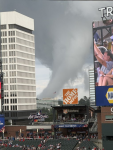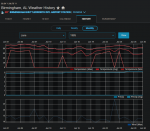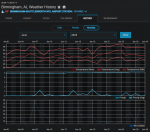You're probably right about the liability issue. I've played a number of courses but the only one where I've observed the lightning system in action is the RTJ course here. They have (or had) a two tiered system, 10 and 5 miles (IIRC). First, you'd hear the 10 mile warning, which was a caution only. Next, when the five mile sounded, it was "everybody off." There was no "play on" option. When anyone stayed on, and someone usually did, staff went out to bring them in. I would suppose that, if you defied them, your playing privileges would be at hazard, I would think...I have been going to the panhandle beaches for 50+ years and I have never seen a lightning detector anywhere except for the local golf courses. I surmise the only reason golf courses have them is for liability concerns. If they have a lightning detector and it goes off, warning you to get to safety, and you ignore that warning then you are at your own peril.
County governments are not that worried about liability issues. Plus, most have signs warning you about the dangers and if you decide to partake of the fun stuff about the beach then you are on your own.
Weather thread, Part III
- Thread starter crimsonaudio
- Start date
You are using an out of date browser. It may not display this or other websites correctly.
You should upgrade or use an alternative browser.
You should upgrade or use an alternative browser.
I learned a new term last night. Scud cloud. Never heard of it until yesterday. There was one near the Braves stadium last night.
Me too!I learned a new term last night. Scud cloud. Never heard of it until yesterday. There was one near the Braves stadium last night.
Brad Nitz (meteorologist):
That’s a scud cloud. Warm moist air rising in a thunderstorm updraft and the water vapor condenses. It’s harmless, but scary looking. No rotation is the key to recognizing scud, not tornado.

i have to say the braves are getting quite creative in finding new, unique excuses for losingI learned a new term last night. Scud cloud. Never heard of it until yesterday. There was one near the Braves stadium last night.
That wasn't a scud cloud. That was the Brave's playoff hopes finally flying away into the sky.I learned a new term last night. Scud cloud. Never heard of it until yesterday. There was one near the Braves stadium last night.
You're crazy, this weather is awesome!
It's "corn sweat" season here in Iowa. Not a dime's difference between this and the stuff we faced in August 2-a-days when I was in high school in Mississippi.
View attachment 51811
I knew a guy from England that moved to Atlanta for work. He asked what was the weather like in March in Atlanta. He was told warm but wet. Now you might ask what year was this? 1993. He brought no winter clothes at all.
Years ago, we used to patronize a sushi restaurant out in Madison called "Edo." At the time, the couple, later divorced, were starting over from moving from the Parkway and University and built it originally in an abandoned gas station. The sushi bar was just as you opened the door, no airlock. The original guy, named Yoshi, had departed and the proprietress had a new partner, a young Japanese who'd only lived in San Diego in the States. He moved here in January. Sometimes, January, particularly up here in HSV, can be brutal and this was one of those. Highs in the teens were common, with lows in the single digits. The new young guy and I developed an acquaintanceship and one evening, when it was a bit slow because of the weather - we were eating in heavy coats - he came around from around the bar and asked me if it were always like this here in January. I told him not usually, but it could be. He didn't last a month before moving back to San Diego...I knew a guy from England that moved to Atlanta for work. He asked what was the weather like in March in Atlanta. He was told warm but wet. Now you might ask what year was this? 1993. He brought no winter clothes at all.
The bank I used to work for often recruited executives from other parts of the country. More than one left a high-six / low-seven figure job because of July and August in Alabama. And this was 20 years ago.
I do wonder on a point. How do today’s heat indices compare to years ago?
Birmingham TV stations trumpet triple-digit heat indices like they were The Rage from the 28 Days movie series. Every day is a “First Alert Weather Day,†and the Apocalypse is upon us. Stay inside in the AC, or you’ll die.
But so far this summer, temps are entirely consistent with my memories from childhood in Tuscaloosa.
Admittedly, back then, nobody talked about the heat index. I’m not even sure that was a thing 50 years ago. We complained that, “It’s not the heat….its the humidity.â€Â
Even though it conveys the same concept, it’s not nearly so compelling as, “The high tomorrow will be 93, but it’ll feel like 105.†Complete with an animated image of a guy in a hospital bed suffering from heat exhaustion.
I’m no climate change denier. But all the breathless hyperbole strikes me as more than a bit overstated.
Yes, it’s hot. It’s Alabama in July and soon to be August. 95 degrees happens. It’s been a while since we had triple digits for multiple days.
Reminds me of constant harping on the price of gasoline or eggs. The publicity was far beyond their true significance. But it’s all they talked about, so the audience follows along, and repeats it ad infinitum to everyone they see.
So back to my original question: Do we have any historical data on heat indices? If so, how does the last week compare to the third week in July?
You can ring the “ First Alert Weather Day†only so many times before you become the boy who cried wolf.
Between freezes, rain, hot temps, and various other alarm-ringing, I fear they’ve already done that. One day, a no-foolin’ weather emergency will crop up. They’ll ring the bell for the 100th time in the past year. And nobody will pay any heed because they’ve overreacted so many times in the recent past.
Over 50 years ago, Howard Beale was right.
I do wonder on a point. How do today’s heat indices compare to years ago?
Birmingham TV stations trumpet triple-digit heat indices like they were The Rage from the 28 Days movie series. Every day is a “First Alert Weather Day,†and the Apocalypse is upon us. Stay inside in the AC, or you’ll die.
But so far this summer, temps are entirely consistent with my memories from childhood in Tuscaloosa.
Admittedly, back then, nobody talked about the heat index. I’m not even sure that was a thing 50 years ago. We complained that, “It’s not the heat….its the humidity.â€Â
Even though it conveys the same concept, it’s not nearly so compelling as, “The high tomorrow will be 93, but it’ll feel like 105.†Complete with an animated image of a guy in a hospital bed suffering from heat exhaustion.
I’m no climate change denier. But all the breathless hyperbole strikes me as more than a bit overstated.
Yes, it’s hot. It’s Alabama in July and soon to be August. 95 degrees happens. It’s been a while since we had triple digits for multiple days.
Reminds me of constant harping on the price of gasoline or eggs. The publicity was far beyond their true significance. But it’s all they talked about, so the audience follows along, and repeats it ad infinitum to everyone they see.
So back to my original question: Do we have any historical data on heat indices? If so, how does the last week compare to the third week in July?
You can ring the “ First Alert Weather Day†only so many times before you become the boy who cried wolf.
Between freezes, rain, hot temps, and various other alarm-ringing, I fear they’ve already done that. One day, a no-foolin’ weather emergency will crop up. They’ll ring the bell for the 100th time in the past year. And nobody will pay any heed because they’ve overreacted so many times in the recent past.
Over 50 years ago, Howard Beale was right.
Last edited:
Thanks, CA. That's good information.The data:
40 years ago (1985)
View attachment 51824
View attachment 51825
This year (2025)
View attachment 51826
View attachment 51827
It is point-to-point, 40 years in between -- not trendline over 40 years vs. what we see today (which analysis would have its own set of shortcomings).
Still, assuming for a minute that 1985 is substantially representative of 1985 - 2025, it looks like the max temps aren't the real change. It's the minimum temps.
As in, the charts don't show it getting that much hotter today than it did in the past. The real difference they show is that it doesn't cool off as much at night.
Even then, I'd have a question about the minimum temps in June of 1985. Chart says 0, and the graph represents that for a bunch of days. I don't know what the issue is, but I know we didn't have a low of 0 degrees on any day in June of 1985, let alone a bunch of them. And we didn't have an average low of a hair under 24. I can't tell how that affects the other minimum and average numbers, but it certainly raises questions.
So something's off. My best guess would be that, for whatever reason, they didn't have any observations for a while, and recorded that as 0. If -- two big letters -- that's right, the minimum (and possibly average) numbers are significantly misleading, especially when included as part of a trendline.
I also see that the chart says we had no rain the entire month of June. Seems unusual, even in a dry year. But maybe so. I do remember some dry summers during that time frame. That could account for the max temp in June of 1985 of 99, whereas in June of 2025 (an unusually wet month) it was 94.
Even that doesn't get into a comparison of the heat indices.
You may know that I'm into the geeky stuff about production of wine. Observations from a lot of US wine grape growers in Napa and the Willamette Valey are consistent with that. As in, they say that they can handle the 105 degree daily high temps, even in Oregon. It's the minimum 85 degree nights that cause the problem.
Last edited:
Yeah, grabbing one month isn't enough data to go on, I initially grabbed 1995 instead of 1985, only to realize there was a heat wave in June of 1995 and the temps were a bit higher than in 2025.Thanks, CA. That's good information.
It is point-to-point, 40 years in between -- not trendline over 40 years vs. what we see today (which analysis would have its own set of shortcomings).
I'm kind of a weather geek and I've been researching temps and trends in the places I lived growing up (Florida) - I can compare average months over time (trends) and have seen very little difference. I'm sure looking at one city (or even state) isn't enough for a global picture, but I've not seen the expected change in overall temps over the last 40-ish years I've looked.
I have similar thoughts from growing up in the Central Valley of California. Moving away from CA introduced me to the national media's obsession w/wildfires in the summer. The wildfires in the West have been a problem that growing up, we called it "wildfire season". It is so dry and hot in the summer time that high winds and temperatures can start a wildfire. Additionally, a lot of these wildfires start in places w/no roads, or no easily accessible roads, so it takes a long time for firefighters to get to where the fire is. This is why they'll quickly train up prisoners w/good behavior to parachute into the wildfires and fight them - if they survive, they'll get a good data point for their parole hearings; if not, well, they didn't survive.The bank I used to work for often recruited executives from other parts of the country. More than one left a high-six / low-seven figure job because of July and August in Alabama. And this was 20 years ago.
I do wonder on a point. How do today’s heat indices compare to years ago?
Birmingham TV stations trumpet triple-digit heat indices like they were The Rage from the 28 Days movie series. Every day is a “First Alert Weather Day,†and the Apocalypse is upon us. Stay inside in the AC, or you’ll die.
But so far this summer, temps are entirely consistent with my memories from childhood in Tuscaloosa.
Admittedly, back then, nobody talked about the heat index. I’m not even sure that was a thing 50 years ago. We complained that, “It’s not the heat….its the humidity.â€Â
Even though it conveys the same concept, it’s not nearly so compelling as, “The high tomorrow will be 93, but it’ll feel like 105.†Complete with an animated image of a guy in a hospital bed suffering from heat exhaustion.
I’m no climate change denier. But all the breathless hyperbole strikes me as more than a bit overstated.
Yes, it’s hot. It’s Alabama in July and soon to be August. 95 degrees happens. It’s been a while since we had triple digits for multiple days.
Reminds me of constant harping on the price of gasoline or eggs. The publicity was far beyond their true significance. But it’s all they talked about, so the audience follows along, and repeats it ad infinitum to everyone they see.
So back to my original question: Do we have any historical data on heat indices? If so, how does the last week compare to the third week in July?
You can ring the “ First Alert Weather Day†only so many times before you become the boy who cried wolf.
Between freezes, rain, hot temps, and various other alarm-ringing, I fear they’ve already done that. One day, a no-foolin’ weather emergency will crop up. They’ll ring the bell for the 100th time in the past year. And nobody will pay any heed because they’ve overreacted so many times in the recent past.
Over 50 years ago, Howard Beale was right.
It's hot in South during the summer time; nothing about that has changed. Anecdotally, it seems like the rain season has gotten longer in the Spring here in Alabama, even going into June. I don't know if that is statistically correct, but since moving to Alabama in 2006, it feels that way.
I knew a guy from England that moved to Atlanta for work. He asked what was the weather like in March in Atlanta. He was told warm but wet. Now you might ask what year was this? 1993. He brought no winter clothes at all.
It's almost state fair season here. Mid -August. Going there during the day is like spending the day in Hell. All that asphalt and unrelenting heat and humidity.
It's almost state fair season here. Mid -August. Going there during the day is like spending the day in Hell. All that asphalt and unrelenting heat and humidity.
I have started carrying an extra shirt on my hikes/rucks/bikes because of the amount of sweat. Even the dryfit shirts get overwhelmed
Yeah, grabbing one month isn't enough data to go on, I initially grabbed 1995 instead of 1985, only to realize there was a heat wave in June of 1995 and the temps were a bit higher than in 2025.
I'm kind of a weather geek and I've been researching temps and trends in the places I lived growing up (Florida) - I can compare average months over time (trends) and have seen very little difference. I'm sure looking at one city (or even state) isn't enough for a global picture, but I've not seen the expected change in overall temps over the last 40-ish years I've looked.
Yeah, what you really need is something it would take a graduate student in Meteorology to put together -- or a supercomputer.
You need a 40 year trendline of 40 consecutive 40 year moving averages.
IOW, start with 1985. The data point for 1985 would be the average max, min and average daily temps for each day in the month of June for the time period 1946 - 1985.
The data point for 1986 would be the same, but for 1947 - 1986. Then 1948 - 1987, 1949 - 1988, and so forth.
To include the heat index, you'd need humidity information for all that.
But I'm an unashamed numbers geek. The above is way too pointy-headed for the majority of people to remain awake while it's being explained.
It's a lot easier to breathlessly talk about triple-digit heat indices, acting as if they're something new for summer in Alabama, and issue dire health warnings if you don't listen to what your superiors tell you and conduct yourself accordingly.
That kind of lazy hyperbolic clickbait, as opposed to rigorous objective analysis, is what gives climate deniers fuel.
Last edited:
Trending content
Latest threads
-
-
Bama Game Thread: Official Game Thread - Bama vs. East. Ill., 1st Half...
- Started by TIDE-HSV
- Replies: 0
-
Bama Game Thread: Official Game Thread - Bama vs. East. Ill., 2nd Half...
- Started by TIDE-HSV
- Replies: 0
-
Bama Game Thread: Official PostGame Thread - Bama vs. East. Ill...
- Started by TIDE-HSV
- Replies: 0
-
ESPN: Sources: Ohio St. to be without WRs Tate, Smith
- Started by TideFans Reporter
- Replies: 0
-







